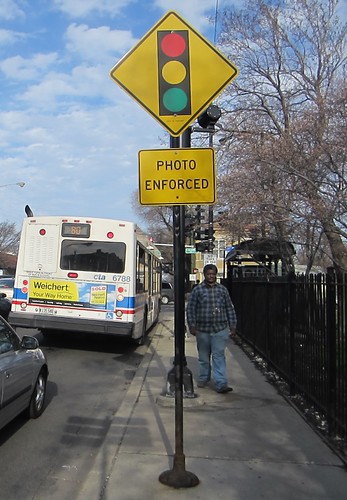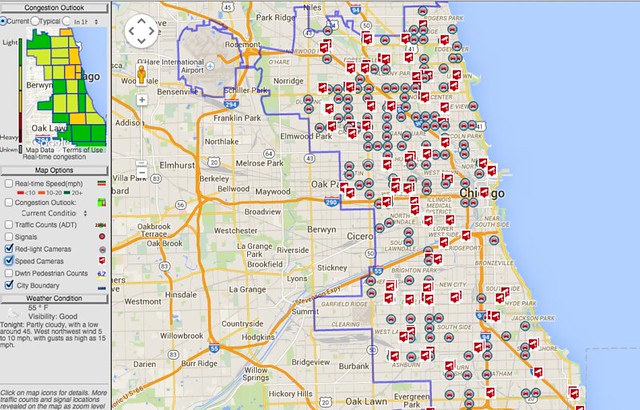Even if you voted for Chuy García, if you know how effective automated enforcement has been for preventing serious crashes in other cities, you may be relieved he didn’t get a chance to shut down all of Chicago’s traffic cameras. However, García and the other challengers did residents a service by drawing attention to ways that the Emanuel administration has mismanaged the program, which forced the mayor to take steps to reform it.
In early March, a few days after García said he would abolish the cams, Emanuel announced he would remove 50 red light cameras at 25 intersections that saw one or fewer right-angle crashes in 2013. He also promised to install pedestrian countdown signals at the 42 out of the city's 174 red-light camera intersections that don’t currently have them, by June 1.
Emanuel proposed giving drivers a “Mulligan” on their first red light violation by allowing them to take an online safety course instead of paying the $100 fine. And he promised that community meetings will be held before red light cameras are installed, moved, or removed. Here are some more steps the mayor should take to make automated enforcement more effective, transparent, and fair.
Monitor cameras more carefully to make sure they are working properly. While the Chicago Tribune has delivered consistently biased coverage of the program, the paper deserves credit for exposing irregularities in enforcement, such as unexplained spikes in ticketing. For example, one North Side camera issued only a dozen tickets for rolling right turns over six months, and then put out 560 tickets for rolling rights within 12 days. The city needs to be vigilant about ticket spikes in the future and immediately address problems that emerge.
Remove cameras from other low-crash locations. It was definitely a step in the right direction to remove cameras from those first 25 low-crash intersections. When cams are installed at locations that don't have a significant crash problem, it suggests that these sites were chosen with revenue -- rather than safety -- in mind. According to a Tribune study, there are 61 other intersections that had three or fewer injury crashes before cameras were installed. The mayor should shut down those cams as well.
Don’t include ticket revenue as a projected funding source in the city budget. If the red light and speed cams are doing their jobs to reduce violations, the number of tickets issued should drop within a few months of installation, which has been the case in Chicago. As a result, revenue from the cams has been lower than projected. Fines should be treated as a way to deter lawbreaking, not as an end in themselves, so the city should not count on them to balance the budget.
Be transparent about changes to the program. It’s a common misconception that the Emanuel shortened yellow light times in order to increase ticket revenue. That wasn't the case, but the city did quietly change its policy to allow tickets to be issued after yellow phases that were a fraction of a second shorter than 3.0 seconds, to allow for minute electrical fluctuations. That move was legal under state law, and the motorists who ran reds after minutely shorter yellows deserved tickets. However, it was politically foolish to make the change without announcing it in advance, because it was only a matter of time before people noticed, which fueled mistrust for the program.
Dispel the myth that the cameras unfairly target low-income neighborhoods. Another common belief is that the majority of red light and speed cams are concentrated on the South and West Sides. A glance at a map of camera locations reveals that isn’t true. Meanwhile, the worst intersections for pedestrian crashes involving children are in low-income neighborhoods on the South and West Sides. From my experience scanning the dailies for Today’s Headlines, it also appears that most of Chicago’s serious car crashes take place in these communities, so their residents have the most to gain from better traffic enforcement.
Reduce the fines, or create a sliding scale. Opponents have characterized the $100 tickets for running reds and speeding as a regressive tax. However, the fines are completely avoidable, and there’s no correlation between income level and the ability to step on a brake pedal. On the other hand, if the city’s chief goal is to reduce the number of serious crashes, rather than raise revenue, perhaps a $75 or $50 fine would be a sufficient deterrent, and would be less of a hardship for low-income and working-class Chicagoans. Ideally, we would follow the lead of European countries that have made traffic fines proportionate to income.
Change the state law to allow speed cameras to be installed outside of school and park zones. To win approval for Chicago’s speed camera program in Springfield, Emanuel promoted the cams as a way to protect children, and proposed a state law that only allows installation within an eighth mile of schools and parks. However, the city should be allowed to place speed cams anywhere there’s a speeding problem, since adults are also endangered by speeders. When cameras are installed near small parks with low foot traffic in order to address a general crash problem in the area, it makes people question whether the cams are there for revenue, rather than to protect park goers. Granted, changing the state law would be an uphill battle, but maybe it's worth a try.
Make damn sure the mayor’s motorcades doesn’t run reds. Over the last three years, there have been at least 22 incidents where the tail car of Emanuel’s two-car motorcade has been caught on camera proceeding through a red after the lead car passed through a yellow. Although Emanuel said he would pay all the tickets, the red light running is an embarrassment that undermines his credibility on safety issues. A new protocol is needed: When the light turns yellow, the lead car stops.






